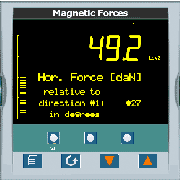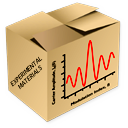High Magnetic Fields
Stray Magnetic Field and Siting Issues

The area of horizontal and vertical magnetic forces accepted on an instrument is defined by: Fh < 100 daN, Fv < 300 daN and Fv+13 Fh < 1300.
The effects of stray magnetic fields on system performance and the environment can often require complex finite element modeling. We therefore provide below some guidelines. We have also constructed a dedicated apparatus for measuring the magnetic forces. The vertical force is measured with a standard dynanometer and the horizontal one is obtained by clamping the device shown below to both the cryomagnet and the sample table. This device measures 3 forces at 120° and calculates the direction and total magnitude of the force.
For safety reasons, the magnetic forces measurements are mandatory after each modification of each instrument. The mechanical limits must always be installed and checked by the instrument responsibles or the local-contact before starting an experiment. From discussions with magnet suppliers and experts, we have established an area of horizontal and vertical forces that must be respected to ensure the safe operation of the instruments. Sometimes, the scattering angles covered by an instrument are limited above a given field. Click on the left menu to get the operation conditions for a given instrument .
Static Steel:
The presence of steel in close proximity to the magnet can cause two possible problems;
1) Excess force on the cryostat components leading to damage to the magnet support system or poor cryogenic performance, or 2) Perturbations of the magnetic field leading to poor homogeneity. In order to avoid these problems it is necessary to ensure that there is no structural steel within the 30 gauss field contour. This distance can be determined from the system stray field plot. Items such as steel beams or pillars and concrete reinforcing can cause problems, in particular any non-symmetric steel in the structure. It is possible that steel in the building will become magnetised and cause areas of increased field at some distance from the system, in particular steel beams may cause increased field areas in adjacent rooms that may affect VDU’s.
Moving Steel
The effect of moving steel can be the same as detailed above with the added problem of field disturbances that may be visible in experimental results. Objects such as vehicles or elevators should be well outside the 1 gauss contour. Large steel equipment, such as gas bottles or pallet trucks, should be kept well outside the 10 gauss contour, movement of this equipment should be controlled as even at this distance effects may be observed. These distances can be determined from the system stray field plot. The relative position and steel content of doors and windows should also be determined.
Approximations to Force Calculation
The force between the magnet and a ferromagnetic object can be approximated if the magnetic field gradient is known. The critical limit is = 500 Gauss/metre; any iron located on this line is exerting a force on the magnet equal to its mass. Any iron within the region bounded by this line is exerting a greater force which can be approximated as force = (mass of iron object) x (field gradient at that point) / 500; e.g. a 5 kg iron mass centred on the 1000 Gauss/metre line will exert a force = 5 x 1000/500 = 10 kgf = approx. 10 daN. However, note that this is only a guideline.
IMPORTANT: If there is any significant amount of ferromagnetic material within 2 metres of magnet centre field, contact us for advice.

Field Limits for Devices (Unshielded Magnet Systems):
The following can affect the system and should be positioned outside of the following limits:
| 1 Gauss | Motor vehicles, Elevators |
| 10 Gauss | Large steel equipment |
| 30 Gauss | Typical structural steel beams |
The following will be affected by the magnetic field and should be outside of the following limits:
| 1 Gauss | Image intensifiers, Electron microscopes, Accurate measuring scales, X-ray machines, Graphics terminals |
| 5 Gauss | Pacemakers, Public access without warning signs, Cathode ray tubes |
| 10 Gauss | Computers, Watches and clocks, Credit cards |
| 20 Gauss | Magnetic storage media |
| 50 Gauss | Magnet power supply |


 (zip - 17.39 Ki)
(zip - 17.39 Ki)